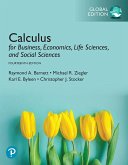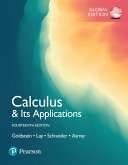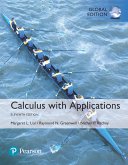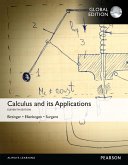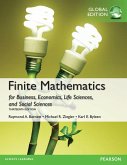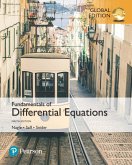Calculus for the Life Sciences, Global Edition (eBook, PDF)


Alle Infos zum eBook verschenken

Calculus for the Life Sciences, Global Edition (eBook, PDF)
- Format: PDF
- Merkliste
- Auf die Merkliste
- Bewerten Bewerten
- Teilen
- Produkt teilen
- Produkterinnerung
- Produkterinnerung

Hier können Sie sich einloggen

Bitte loggen Sie sich zunächst in Ihr Kundenkonto ein oder registrieren Sie sich bei bücher.de, um das eBook-Abo tolino select nutzen zu können.
The full text downloaded to your computer
With eBooks you can:
search for key concepts, words and phrases | make highlights and notes as you study | share your notes with friends
eBooks are downloaded to your computer and accessible either offline through the Bookshelf (available as a free download), available online and also via the iPad and Android apps.
Upon purchase, you'll gain instant access to this eBook.
Time limit
The eBooks products do not have an expiry date. You will continue to access your digital ebook products whilst you have your Bookshelf installed.
…mehr
- Geräte: PC
- ohne Kopierschutz
- eBook Hilfe
![Calculus for Business, Economics, Life Sciences, and Social Sciences, Global Edition (eBook, PDF) Calculus for Business, Economics, Life Sciences, and Social Sciences, Global Edition (eBook, PDF)]() Raymond A. BarnettCalculus for Business, Economics, Life Sciences, and Social Sciences, Global Edition (eBook, PDF)43,95 €
Raymond A. BarnettCalculus for Business, Economics, Life Sciences, and Social Sciences, Global Edition (eBook, PDF)43,95 €![Calculus & Its Applications, Global Edition (eBook, PDF) Calculus & Its Applications, Global Edition (eBook, PDF)]() Larry J. GoldsteinCalculus & Its Applications, Global Edition (eBook, PDF)43,95 €
Larry J. GoldsteinCalculus & Its Applications, Global Edition (eBook, PDF)43,95 €![Calculus with Applications, eBook, Global Edition (eBook, PDF) Calculus with Applications, eBook, Global Edition (eBook, PDF)]() Margaret L. LialCalculus with Applications, eBook, Global Edition (eBook, PDF)43,95 €
Margaret L. LialCalculus with Applications, eBook, Global Edition (eBook, PDF)43,95 €![Calculus For Biology and Medicine: Pearson New International Edition PDF eBook (eBook, PDF) Calculus For Biology and Medicine: Pearson New International Edition PDF eBook (eBook, PDF)]() Claudia NeuhauserCalculus For Biology and Medicine: Pearson New International Edition PDF eBook (eBook, PDF)43,95 €
Claudia NeuhauserCalculus For Biology and Medicine: Pearson New International Edition PDF eBook (eBook, PDF)43,95 €![Calculus And Its Applications, Global Edition (eBook, PDF) Calculus And Its Applications, Global Edition (eBook, PDF)]() Marvin L. BittingerCalculus And Its Applications, Global Edition (eBook, PDF)43,95 €
Marvin L. BittingerCalculus And Its Applications, Global Edition (eBook, PDF)43,95 €![e Book Instant Access for Finite Mathematics for Business, Economics, Life Sciences and Social Sciences,Global Edition (eBook, PDF) e Book Instant Access for Finite Mathematics for Business, Economics, Life Sciences and Social Sciences,Global Edition (eBook, PDF)]() Raymond A. Barnette Book Instant Access for Finite Mathematics for Business, Economics, Life Sciences and Social Sciences,Global Edition (eBook, PDF)43,95 €
Raymond A. Barnette Book Instant Access for Finite Mathematics for Business, Economics, Life Sciences and Social Sciences,Global Edition (eBook, PDF)43,95 €![Fundamentals of Differential Equations, Global Edition (eBook, PDF) Fundamentals of Differential Equations, Global Edition (eBook, PDF)]() R. Kent NagleFundamentals of Differential Equations, Global Edition (eBook, PDF)43,95 €
R. Kent NagleFundamentals of Differential Equations, Global Edition (eBook, PDF)43,95 €-
-
-
With eBooks you can:
- search for key concepts, words and phrases
- make highlights and notes as you study
- share your notes with friends
eBooks are downloaded to your computer and accessible either offline through the Bookshelf (available as a free download), available online and also via the iPad and Android apps.
Upon purchase, you'll gain instant access to this eBook.
Time limit
The eBooks products do not have an expiry date. You will continue to access your digital ebook products whilst you have your Bookshelf installed.
Calculus for the Life Sciences features interesting, relevant applications that motivate students and highlight the utility of mathematics for the life sciences. This edition also features new ways to engage students with the material, such as Your Turn exercises.
Dieser Download kann aus rechtlichen Gründen nur mit Rechnungsadresse in A, B, BG, CY, CZ, D, DK, EW, E, FIN, F, GR, HR, H, IRL, I, LT, L, LR, M, NL, PL, P, R, S, SLO, SK ausgeliefert werden.
- Produktdetails
- Verlag: Pearson HigherEducation
- Seitenzahl: 900
- Altersempfehlung: ab 18 Jahre
- Erscheinungstermin: 5. März 2015
- Englisch
- ISBN-13: 9781292071978
- Artikelnr.: 42511056
- Verlag: Pearson HigherEducation
- Seitenzahl: 900
- Altersempfehlung: ab 18 Jahre
- Erscheinungstermin: 5. März 2015
- Englisch
- ISBN-13: 9781292071978
- Artikelnr.: 42511056
- Herstellerkennzeichnung Die Herstellerinformationen sind derzeit nicht verfügbar.
Raymond has published articles on fluid mechanics, mathematical biology, genetic algorithms, combinatorics, statistics, and undergraduate mathematics education. He is a member of MAA, AMS, SIAM, NCTM, and AMATYC. He has served as governor of the Metropolitan New York Section of the MAA, as well as webmaster and liaison coordinator, and he received a distinguished service award from the Section in 2003. He is an outdoor enthusiast and leads trips in the Sierra Club's Inner City Outings program.
Nathan P. Ritchey earned a B.A. in Mathematics with a minor in Music from Mansfield University of Pennsylvania. He earned a M.S. in Applied Mathematics and a Ph.D. in Mathematics from Carnegie Mellon University. He is currently the Dean of the College of Science and Health Professions at Edinboro University. He has published articles in economics, honors education, medicine, mathematics, operations research, and student recruitment. Nate is a Consultant/Evaluator for the North Central Association's Higher Learning Commission and regularly participates in program evaluations.
In recognition of his numerous activities, Nate has received the Distinguished Professor Award for University Service, the Youngstown Vindicator's "People Who Make a Difference Award," the Watson Merit Award for Department Chairs, the Spirit in Education Award from the SunTex corporation, and the Provost's Merit Award for significant contributions to the Honors Program. A father of four children, Nate enthusiastically coaches soccer and softball. He also loves music, playing several instruments, and is a tenor in the Shenango Valley Chorale. More information about Nate Ritchey can be found at: http://www.as.ysu.edu/~nate/.
Marge Lial (late) was always interested in math; it was her favorite subject in the first grade! Marge's intense desire to educate both her students and herself has inspired the writing of numerous best-selling textbooks. Marge, who received bachelor's and master's degrees from California State University at Sacramento, was affiliated with American River College. An avid reader and traveler, her travel experiences often find their way into her books as applications, exercise sets, and feature sets. Her interest in archeology lead to trips to various digs and ruin sites, producing some fascinating problems for her textbooks involving such topics as the building of Mayan pyramids and the acoustics of ancient ball courts in the Yucatan.
R.1 Polynomials
R.2 Factoring
R.3 Rational Expressions
R.4 Equations
R.5 Inequalities
R.6 Exponents
R.7 Radicals
1. Functions
1.1 Lines and Linear Functions
1.2 The Least Squares Line
1.3 Properties of Functions
1.4 Quadratic Functions; Translation and Reflection
1.5 Polynomial and Rational Functions
Chapter Review
Extended Application: Using Extrapolation to Predict Life Expectancy
2. Exponential, Logarithmic, and Trigonometric Functions
2.1 Exponential Functions
2.2 Logarithmic Functions
2.3 Applications: Growth and Decay
2.4 Trigonometric Functions
Chapter Review
Extended Application: Power Functions
3. The Derivative
3.1 Limits
3.2 Continuity
3.3 Rates of Change
3.4 Definition of the Derivative
3.5 Graphical Differentiation
Chapter Review
Extended Application: A Model For Drugs Administered Intravenously
4. Calculating the Derivative
4.1 Techniques for Finding Derivatives
4.2 Derivatives of Products and Quotients
4.3 The Chain Rule
4.4 Derivatives of Exponential Functions
4.5 Derivatives of Logarithmic Functions
4.6 Derivatives of Trigonometric Functions
Chapter Review
Extended Application: Managing Renewable Resources
5. Graphs and the Derivative
5.1 Increasing and Decreasing Functions
5.2 Relative Extrema
5.3 Higher Derivatives, Concavity, and the Second Derivative Test
5.4 Curve Sketching
Chapter Review
Extended Application: A Drug Concentration Model for Orally Administered
Medications
6. Applications of the Derivative
6.1 Absolute Extrema
6.2 Applications of Extrema
6.3 Implicit Differentiation
6.4 Related Rates
6.5 Differentials: Linear Approximation
Chapter Review
Extended Application: A Total Cost Model for a Training Program
7. Integration
7.1 Antiderivatives
7.2 Substitution
7.3 Area and the Definite Integral
7.4 The Fundamental Theorem of Calculus
7.5 The Area Between Two Curves
Chapter Review
Extended Application: Estimating Depletion Dates for Minerals
8. Further Techniques and Applications of Integration
8.1 Numerical Integration
8.2 Integration by Parts
8.3 Volume and Average Value
8.4 Improper Integrals
Chapter Review
Extended Application: Flow Systems
9. Multivariable Calculus
9.1 Functions of Several Variables
9.2 Partial Derivatives
9.3 Maxima and Minima
9.4 Total Differentials and Approximations
9.5 Double Integrals
Chapter Review
Extended Application: Optimization for a Predator
10. Matrices
10.1 Solution of Linear Systems
10.2 Addition and Subtraction of Matrices
10.3 Multiplication of Matrices
10.4 Matrix Inverses
10.5 Eigenvalues and Eigenvectors
Chapter Review
Extended Application: Contagion
11. Differential Equations
11.1 Solutions of Elementary and Separable Differential Equations
11.2 Linear First-Order Differential Equations
11.3 Euler's Method
11.4 Linear Systems of Differential Equations
11.5 Non-Linear Systems of Differential Equations
11.6 Applications of Differential Equations
Chapter Review
Extended Application: Pollution of the Great Lakes
12. Probability
R.1 Polynomials
R.2 Factoring
R.3 Rational Expressions
R.4 Equations
R.5 Inequalities
R.6 Exponents
R.7 Radicals
1. Functions
1.1 Lines and Linear Functions
1.2 The Least Squares Line
1.3 Properties of Functions
1.4 Quadratic Functions; Translation and Reflection
1.5 Polynomial and Rational Functions
Chapter Review
Extended Application: Using Extrapolation to Predict Life Expectancy
2. Exponential, Logarithmic, and Trigonometric Functions
2.1 Exponential Functions
2.2 Logarithmic Functions
2.3 Applications: Growth and Decay
2.4 Trigonometric Functions
Chapter Review
Extended Application: Power Functions
3. The Derivative
3.1 Limits
3.2 Continuity
3.3 Rates of Change
3.4 Definition of the Derivative
3.5 Graphical Differentiation
Chapter Review
Extended Application: A Model For Drugs Administered Intravenously
4. Calculating the Derivative
4.1 Techniques for Finding Derivatives
4.2 Derivatives of Products and Quotients
4.3 The Chain Rule
4.4 Derivatives of Exponential Functions
4.5 Derivatives of Logarithmic Functions
4.6 Derivatives of Trigonometric Functions
Chapter Review
Extended Application: Managing Renewable Resources
5. Graphs and the Derivative
5.1 Increasing and Decreasing Functions
5.2 Relative Extrema
5.3 Higher Derivatives, Concavity, and the Second Derivative Test
5.4 Curve Sketching
Chapter Review
Extended Application: A Drug Concentration Model for Orally Administered
Medications
6. Applications of the Derivative
6.1 Absolute Extrema
6.2 Applications of Extrema
6.3 Implicit Differentiation
6.4 Related Rates
6.5 Differentials: Linear Approximation
Chapter Review
Extended Application: A Total Cost Model for a Training Program
7. Integration
7.1 Antiderivatives
7.2 Substitution
7.3 Area and the Definite Integral
7.4 The Fundamental Theorem of Calculus
7.5 The Area Between Two Curves
Chapter Review
Extended Application: Estimating Depletion Dates for Minerals
8. Further Techniques and Applications of Integration
8.1 Numerical Integration
8.2 Integration by Parts
8.3 Volume and Average Value
8.4 Improper Integrals
Chapter Review
Extended Application: Flow Systems
9. Multivariable Calculus
9.1 Functions of Several Variables
9.2 Partial Derivatives
9.3 Maxima and Minima
9.4 Total Differentials and Approximations
9.5 Double Integrals
Chapter Review
Extended Application: Optimization for a Predator
10. Matrices
10.1 Solution of Linear Systems
10.2 Addition and Subtraction of Matrices
10.3 Multiplication of Matrices
10.4 Matrix Inverses
10.5 Eigenvalues and Eigenvectors
Chapter Review
Extended Application: Contagion
11. Differential Equations
11.1 Solutions of Elementary and Separable Differential Equations
11.2 Linear First-Order Differential Equations
11.3 Euler's Method
11.4 Linear Systems of Differential Equations
11.5 Non-Linear Systems of Differential Equations
11.6 Applications of Differential Equations
Chapter Review
Extended Application: Pollution of the Great Lakes
12. Probability

